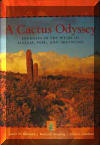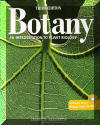|
Introduction

Epidermis

Cortex

Leaves

Spines

Poisons

Wood

Root Succulence

Apical Meristems

Cephalia

Flowers

Travel

Published papers
| |
Root Succulence in Cacti
Roots of some cacti become enlarged and succulent, but by a mechanism
completely different from that in shoots. Shoot succulence in cacti is always
based on primary tissues, always at least cortex, sometimes pith as well. But
Matt Stone-Palmquist found that in cacti with enlarged, succulent roots, it is
always secondary tissues – specifically secondary xylem (wood) – that becomes
enlarged. As in most dicots, the cortex of cactus roots is shed very early,
while the roots are still very narrow; as a result, one of the interior tissues,
probably the endodermis but perhaps the pericycle, becomes the effective root
surface. Whichever tissue it is, it immediately begins to act as a cork cambium
and produces a bark even while the root is young. Simultaneously, a vascular
cambium develops between xylem and phloem and begins adding conducting tissues
to the root. In cacti with ordinary, non-succulent roots, the root wood usually has a
matrix of xylem fibers even if the shoot has WBT wood or parenchymatous wood.
The root vascular cambium produces wood rather slowly such that even old roots
remain rather narrow and tough. But in the species with enlarged succulent
roots, the vascular cambium produces copious amounts of wood, each year
producing much more than is produced in the stem of the same plant. This rapid
growth is possible because the wood has large amounts of relatively inexpensive
cells such as parenchyma or WBTs. Very often the rays are extremely wide, but
the axial tissues derived from the fusiform initials also have abundant
parenchyma in addition to vessels and a few fibers.
Only a few species of cacti have succulent roots, which is surprising
considering the advantages that these provide relative to succulent stems. By
storing water within roots, the water is in a microhabitat that is cooler and more
moist than that which surrounds the stem, and succulent roots are more
well-hidden from thirsty animals. However, succulent roots are found
only in cacti with rather small stems; such small stems can benefit from the
water stored in rather small roots, the type that can grow in rocky soil. For
succulent roots to be of much benefit to giant columnar cacti, the roots would
have to be large, so large that it is unlikely they could possibly develop in
the rocky soil needed to provide stability for a large shoot. Truly giant roots
could develop only in sandy soils, but such soils are not strong enough to
stabilize big plants.
The storage
function of enlarged roots of cacti certainly involves starch, because most root
parenchyma cells have high concentrations of starch grains. It would appear that
the roots also store water for the plant as well because the root cells are not
usually packed with starch grains so there is plenty of room for water. In
species with succulent roots, the roots have wood-based succulence whereas the
shoots have cortex-based succulence, and wood in the shoots basically just
conducts water whereas that in the roots not only conducts water but also stores
water and starch: wood in the two different organs has distinct functions within
a particular plant, and not surprisingly Matt Stone-Palmquist found that the two
woods almost always have distinct anatomy.
Mauseth, J. D., and M. E.
Stone-Palmquist. 2001. Root wood differs strongly from shoot wood within
individual plants of many Cactaceae. The International Journal of Plant Research
162: 767 – 776.
Stone-Palmquist, M., and J. D.
Mauseth. 2002. The structure of enlarged storage roots in cacti. The
International Journal of Plant Research 163: 89 – 98.
[End Root
Succulence page]


|
